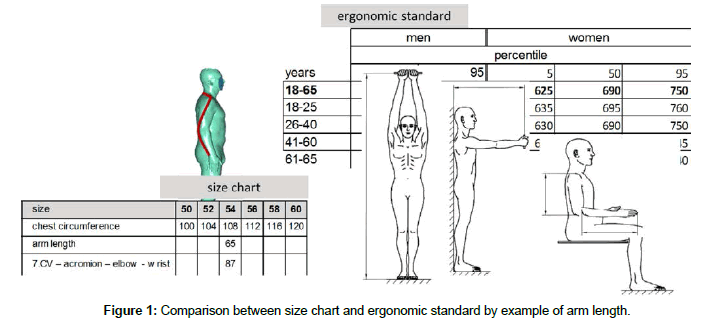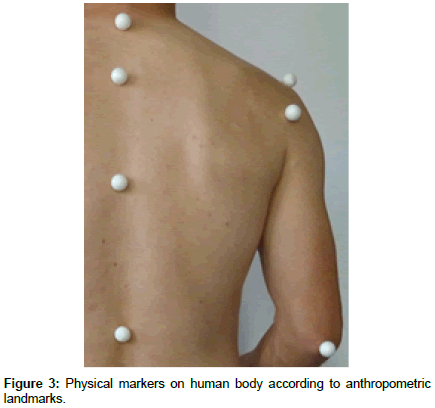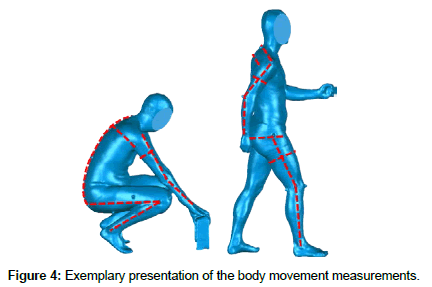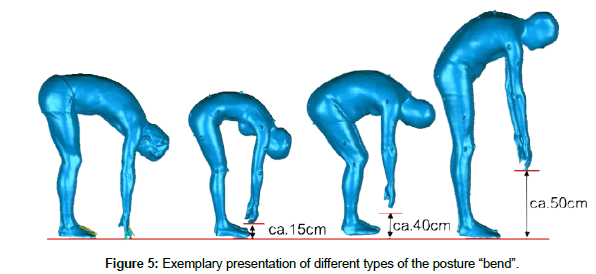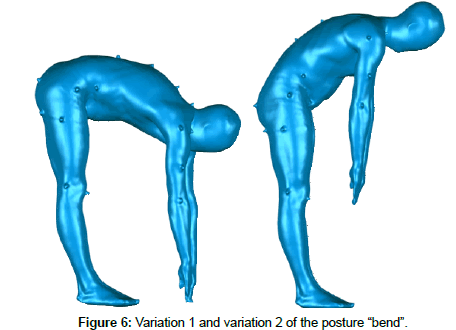Research Article, J Fashion Technol Textile Eng S Vol: 0 Issue: 4
Design of a Motion-Oriented Size System for Optimizing Professional Clothing and Personal Protective Equipment
Christine Loercher*, Simone Morlock and Andreas Schenk
Hohenstein Institut fuer Textilinnovation gGmbH, Boennigheim, Germany
*Corresponding Author : Christine Lörcher
Hohenstein Institut fuer Textilinnovation gGmbH, Schlossteige 1, 74357 Boennigheim, Germany
Tel: +49 7143 271 543
E-mail: c.loercher@hohenstein.de
Received: December 08, 2017 Accepted: February 28, 2018 Published: 05, 2018
Citation: Loercher C, Morlock S, Schenk A (2018) Design of a Motion-Oriented Size System for Optimizing Professional Clothing and Personal Protective Equipment. J Fashion Technol Textile Eng S4:014. doi:10.4172/2329-9568.S4-014
Abstract
The fit, comfort and the fashionable look of professional clothing as well as personal protective equipment (PPE) gain in importance. In addition to the protection and functional properties, the working and protective clothing demands perfect fit for optimal freedom of movement. The balancing act between freedom of movement, functionality and fashion-oriented fit of different target groups offers new complex challenges to manufacturer of professional clothing. Anthropometric data are used for clothing design, PPE, workstations and man-machine interfaces. Therefore two different measuring systems are used: size charts and ergonomic standards. Size charts are the base for clothing industry, however size charts cannot cover the functional requirements of professional clothing and PPE. The body measurements during exercising movements (standing, sitting, kneeling, etc.) deviate significantly from the measurements of size charts, which are measured in standard standing position. The motion-related variability of body dimensions is partly reflected in ergonomic standards. The ergonomic standards describe different modes of motion, e.g. arm range, without any size references, only percentiles type. A measurement standard which considers size reference as well as function-oriented motion of the body at work, is currently not available.
In the project "functional dimension“ the motion-related variability of body measurements are investigated and converted into a new size system. The following work steps are in the presented project: analysis and classification of work-related postures (standing, sitting, etc.), posture capturing by using 3D-scanner technology,identification of changes in the motion-dependent body shape and analysis of the extrema, statistical evaluation of ergonomic dimensions, development of ergonomic and motion-related size systems.
The aim of the project is to re-evaluate fundamentally the motioninduced changes of the body, to identify the respective characteristic and to derive new defined functional dimensions. The new motionoriented size system allows fitting and ergonomically based design of function-oriented, comfortable and fashionable professional clothing and PPE in future. The challenge consists of the systematic derivation of new functional dimensions as well as their conversion into optimized clothing products in addition to reproducible detection of the ROM (range of motion).
Keywords: Personal protective equipment; Professional clothing; Size charts; Motion-oriented measurement system; Anthropometric data
Introduction
The most important properties of professional clothing and personal protective equipment (PPE) are protection and functionality, but many customers are no longer satisfied with a standard solution with regard to fit and ergonomic comfort. It is required to have a fit-proof and visually appealing professional clothing and PPE, which also offers optimum freedom of movement [1-3]. The balancing act between freedom of movement, functionality, protection and the fashionoriented fit of different target groups offers new complex challenges to the manufacturer.
The anthropometric data are normally used for clothing design, PPE, man-machine interfaces and workstations. For this proposal two different measuring systems are currently used: size charts and ergonomic standards [1-8]. Size charts are the base for clothing industry, but they cannot cover the functional requirements of professional clothing and PPE.
In comparison to the standard measurements for size charts, the body measurements during exercising movements (standing, sitting, kneeling, etc.) deviate significantly.
The motion-related variability of body dimensions like lengths and circumferences is partly reflected in ergonomic standards [4-6]. But the ergonomic standards just describe different modes of motion, e.g. arm range, without any size references, only percentiles type. Due to this, the correlation between the two measurement systems is missing (Figure 1).
Many international studies emphasize the issues and needs for body movement integration into clothing [9-11]. Scientific research was realized especially in the field of PPE [12-15] particularly in the field of fire-fighting [16-19], military [20] and rescue service [21]. The sports sector also deals with the implementation of body movement in clothing [22,23] inter alia. Eungpinichpong, et al. [24] investigates the effects of wearing too tight and ill-fitting pants on the lumbar region and muscle activity. Discomfort and poor fit of trousers in the hip area could be clearly demonstrated and confirm the need to consider the range of motion (ROM) for people in development of clothing. The integration of body measurements and movements to a new size system has not been realized yet. This was the starting point of the project.
Methods
In the research project "functional dimensions" [3,25] the movementrelated variability of body measurements is investigated and a new motion-oriented system shall be developed.
The presented project includes the following work steps: Analysis and classification of work-related postures (standing, sitting, kneeling, etc.) and motion sequences, posture capturing using 3D-scanner technology, identification of changes in the motion-dependent body shape and analysis of the extrema for derivation of the motion-oriented measurements, statistical evaluation of ergonomic dimensions according to sizes, figure types as well as size series, development of ergonomic and motion-related size systems for men and women.
The identification and classification of representative types of movement, which reflect as many professional activities as possible, was important to develop specific scanning positions. One main aim was to define particular postures in a way that test subjects can adopt these postures in a reproducible and repeatable manner. In addition, it was necessary to specify postures that enable the bodyscanner Vitus Smart XXL to capture all relevant body areas.
The analysis has resulted in 10 different scan postures, which can be seen in Figure 2. These postures are: standing in different positions, sitting in different positions, bending, squatting as well as standing in a lunge. Each test subject was scanned in these 10 scan postures. Some of the postures from the SizeGermany survey [1] (like standing and sitting positions) are used as references for the evaluation afterwards.
Additionally, to the scan postures, a total of 16 physical markers made of styrofoam have to be applied on test subject’s bodies at specific anthropometric measuring points before scanning. This enables the analyze and measurement of the differences in lengths and circumferences reproducibly. Figure 3 shows exemplary the Styrofoam markers.
The identification of changes in motion-dependent and posturedependent body shape as well as the analysis of the extrema for derivation of the new functional dimensions plays also a major role.
The definition of significant measurements is essential besides the other work steps. The measurements of adopted postures are compared with reference postures in order to determine the changes. Altogether, about 21 measurements were determined. Figure 4 shows exemplary some of these measurements. Important measurements are chest circumference, arm, leg and back lengths, back and chest width as well as leg and arm circumferences. However, the distances between markers on the back in different postures are also measured.
Based on the first data analysis, it has been found that reproducibility is also an important aspect. As an example, the postures “bend” and “squad” can be mentioned. Figure 5 shows different types of the posture “bend” due to the different physical abilities of the test subjects.
This posture had to be redefined due to the first findings. These postures had to be scanned in two different variations in order to be able to sustain the reproducibility and to evaluate the results later in relation to the body height (Figure 6):
• Variation 1: To bend as far forward as possible according to the physical constitution of test subject
• Variation 2: To bend to the reference point at the middle knee point.
The posture “squad” depicts also some challenges as mentioned above. Figure 7 shows the position of the markers on the test subject’s back in the posture “squad”. The position of the markers can change, depending on the abilities of the test subject and the performance of the posture. For this reason, the results of the measurement can be difficult and it could vary widely.
To ensure the comparability and reproducibility, an accurate instruction and review during the scanning process is necessary.
Results and Conclusions
The innovative aim of the project is to fundamentally re-evaluate the motion-induced body changes, identify the respective mean degree of expression and derive new defined functional dimensions. Results are converted into an ergonomic and motion-oriented size system for efficient application of functional dimensions in clothing industry. This includes functional dimension charts for various figure types and size series and - in this the new solution approach - for relevant different motions. This requires a multidimensional representation of the dimensions. The connection to traditional clothing sizes and known size designations ensures the acceptance and application of a new size system in practice. Focus of the research is on ergonomic design of professional and protective clothing and thus the analysis of work-type body postures and movement sequences. Many of these movements coincide with those of different sports.
In a first step, however, it is useful to limit the wide range of analysis to the field of occupation, and to examine the transfer to other fields in a second step. There are large differences between the genders in body forms, proportions and muscle manifestations [1,4,26,27]. Due to this, research of the functional dimensions should be carried out for men and women. The combination of all results from the investigation is used to optimize the presentation and use of the multi-dimensional content by developing a software-based user-friendly application. In addition to the movement-oriented body data, optimized size allocation systems are developed which decisively support and improve the process of size fitting and size allocation.
Acknowledgments
IGF 18993 N under the auspices of the Research Association Forschungskuratorium Textil e.V., Reinhardtstraße 12-14 10117 Berlin, was sponsored via the AIF as part of the programme to support "Industrial Community Research and Development" (IGF), with funds from the Federal Ministry of Economics and Energy (BMWi) following an Order by the German Federal Parliament.
References
- SizeGermany (2013) Hohenstein institute & human solution GmbH.
- Beuth (2005) Ergonomie-Körpermaße des Menschen - Teil 2 Werte. Deutsches Institut für Normung, Berlin, Germany.
- Morlock S, Lörcher C (2016) Entwicklung eines ergonomisch- und bewegungsorientierten Größensystems für Funktionsmaße zur optimierten Gestaltung von Berufs- und Schutzbekleidung, IGF Project 18993 N, Hohenstein Institut für Textilinnovation, Germany.
- International Organization for Standardization (2010) Basic human body measurements for technological design -- Part 2: Statistical summaries of body measurements from national populations.
- Scheffler C, Schüler G (2013) KAN-Studie 51 rohfassung eines leitfadens für die richtige auswahl und anwendung anthropometrischer daten.
- Hsiao H, Whitestone J, Kau TY, Whisler R, Routley JG, et al. (2014) Sizing firefighters - method and implications. Hum Factors 56: 873-910.
- Jürgens HW, Mathdorff I, Windberg J (1998) Internationale anthropometrische Daten als Voraussetzung für die Gestaltung Arbeitsplätzen und Maschinen. Bundesanstalt für Arbeitsschutz und Arbeitsmedizin, Germany.
- Morlock S, Schenk A, Klepser A (2016) XL plus men - new data on garment sizes. Proceedings of the 7th International Conference on 3D Body Scanning Technologies, Lugano, Switzerland.
- Song G (2011) Improving comfort in clothing. (1st Edtn), Woodhead Publishing Limited, Sawston, United Kingdom.
- Baytar F, Aultman J, Han J (2012) 3D body scanning for examining active body positions: an exploratory study for re-designing scrubs. 3rd International Conference on 3D Body Scanning Technologies, Lugano, Switzerland.
- Aldrich W, Smith B, Dong F (1998) Obtaining repeatability of natural extended upper body positions: its use in comparisons of the functional comfort of garments. Journal of Fashion Marketing and Management 2: 329-351.
- Adams PS, Keyserling WM (1993) Three methods for measuring range of motion while wearing protective clothing: A comparative study. Int J Ind Ergonom 12: 177-191.
- Hsiao H (2013) Anthropometric procedures for protective equipment sizing and design. Hum Factors 55: 6-35.
- Huck J (1988) Protective clothing systems: A technique for evaluating restriction of wearer mobility. Appl Ergon 19: 185-190.
- Huck J (1991) Restriction to movement in fire-fighter protective clothing: evaluation of alternative sleeves and liners. Appl Ergon 22: 91-100.
- Park H, Kim S, Wu Y, Allen NE (2014) Beyond protection-technology and design moving towards human factors of fire gear. AATCC 14: 40-45.
- Coca A, Williams WJ, Roberge RJ, Powell JB (2010) Effects of fire fighter protective ensembles on mobility and performance. Appl Ergon 41: 636-641.
- Son SY, Bakri I, Muraki S, Tochihara Y (2014) Comparison of firefighters and non-f. and the test methods used regarding the effects of PPE on individual mobility. Appl Ergon 45: 1019-1027.
- Lee YA, Park SM (2011) Comparative analysis between 3D visual fit and wearers’ subjective acceptability. 2nd International Conference on 3D Body Scanning Technologies, Lugano, Switzerland.
- Goldman RF, Kampmann B (2007) Handbook on clothing-biomedical effects of military clothing and equipment systems. Defense Technical Information Center, Virginia, USA.
- Grau N, Lacharmoise P, Garcia V (2014) Ergonomic Design of multiprotective clothing for emergeny rescue teams. Ambience 14&10i3m, Tampere, Finland.
- Ebert C (2015) Neuentwicklter Stretchindex. Sport Mode 2: 63.
- Choi J, Hong K (2015) 3D skin length deformation of lower body during knee joint flexion for the practical application of functional sportswear. Appl Ergon 48: 186-201.
- Eungpinichpong W, Buttagat V, Areeudomwong P, Pramodhyakul N, Swangnetr M, et al. (2013) Effects of restrictive clothing on lumbar range of motion and trunk muscle activity in young adult worker manual material handling. Appl Ergon 44: 1024-1032.
- Morlock S (2016) Funktionsmaße - Bewegungsorientierte 3D-analyse von körpermaßen. Wehrtechnisches Symposium, Erding, Germany.
- Morlock S, Wendt E, Kirchdörfer E (2009) Grundsatzuntersuchung zur konstruktion passformgerechter bekleidung für frauen mit starken figuren. AiF- 15144 BG, BPI, Hohenstein, TU Dresden, Hohenstein, Germany.
- Schmid U, Mecheels J (1981) Kräfte an textilien und nähten der kleidung in abhängigkeit von körperbewegungen und kleidungsschnitt. Bekleidung und Wäsche 2: 77-82.
 Spanish
Spanish  Chinese
Chinese  Russian
Russian  German
German  French
French  Japanese
Japanese  Portuguese
Portuguese  Hindi
Hindi 